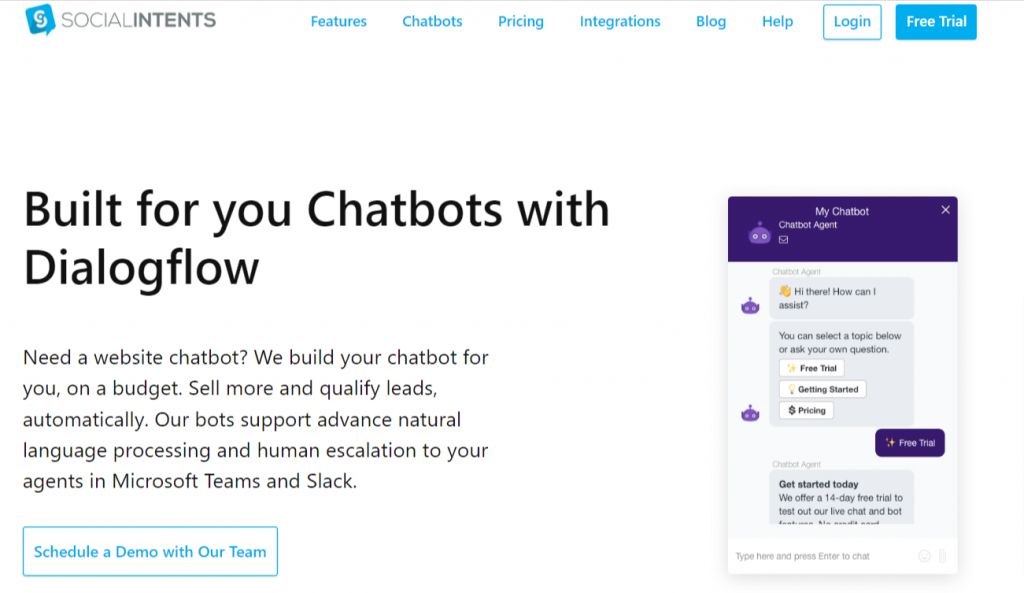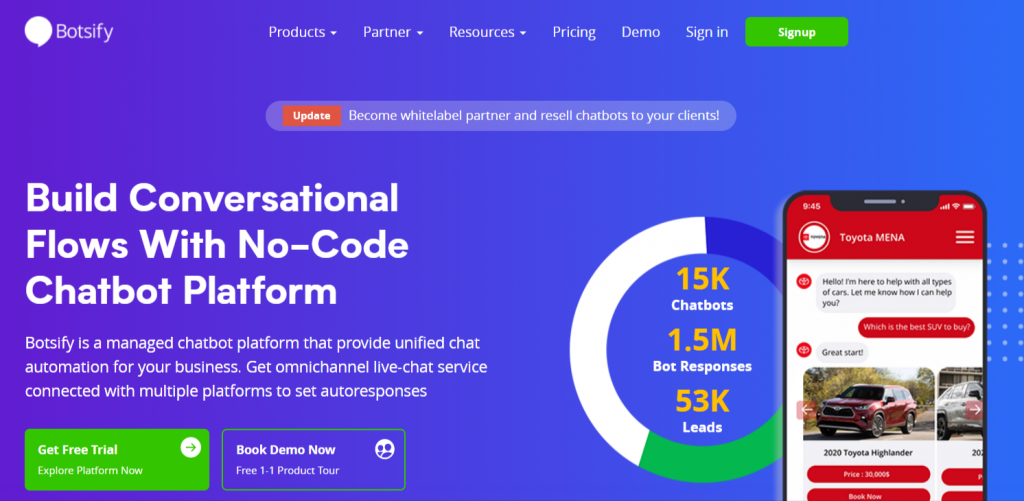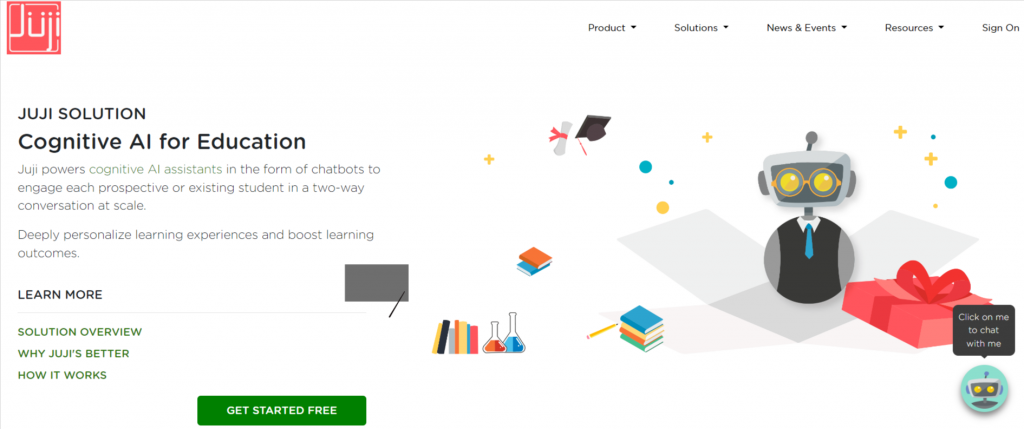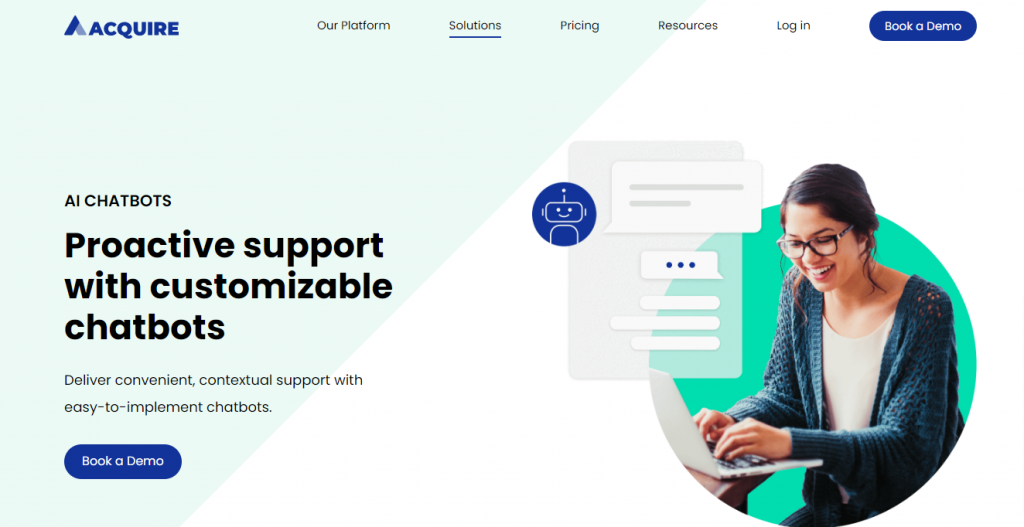¿Está pensando en implantar chatbots en su centro educativo? ¿Se pregunta qué valor aportan los chatbots a las instituciones educativas y cómo podrían ayudar también a la suya?
HECHO: Entre 2020 y 2024, el mercado estadounidense del e-learning podría crecer en ¡72.410 millones de dólares!
Aunque el mercado del aprendizaje electrónico tiene ya 22 años, la pandemia mundial dio a su crecimiento otra proporción totalmente distinta:

En resumen, la industria mundial de la educación en línea ha crecido desde su nacimiento un 900%, con un aumento del 200% sólo desde 2020.
Pero incluso después de la apertura de las escuelas, tanto alumnos como profesores se inclinan por un modelo de educación híbrido, en el que el proceso de aprendizaje presencial y en línea van de la mano. ¿El motivo?
Cada vez más estudiantes consideran que la calidad de la educación en línea es mejor que la presencial, como estos universitarios en Estados Unidos en 2020.

No se trata sólo de colegios e institutos, más del 40% de las empresas de la lista Fortune 500 utilizan el e-learning con regularidad.
Mientras que la realidad virtual y aumentada es todavía una cosa del futuro para la industria de la educación en línea, los chatbots de IA ya están desempeñando un papel importante para convertirla en la herramienta eficiente que es hoy.
Y eso es lo que vamos a tratar en detalle en este artículo.
Manos a la obra.
Qué es un chatbot
En el nivel más básico, un chatbot es un programa informático que simula y procesa la conversación humana (escrita u oral), permitiendo a los humanos interactuar con dispositivos digitales como si se estuvieran comunicando con una persona real. - Oracle
Dos puntos dignos de mención:
- Los chatbots no sólo funcionan a través del texto, sino también de la voz
- Como los chatbots simulan una conversación humana, no sólo pueden responder a tus preguntas, sino también iniciar una conversación por sí solos.
Los chatbots se dividen en dos grandes categorías:
- Chatbots orientados a tareas o sin estado: capaces de realizar una función cada vez. Piense en preguntas frecuentes, consultas con variables limitadas, etc.
- Chatbots basados en datos o en estados: capaces de realizar tareas sofisticadas, interactivas y personalizadas. Piense en asistentes virtuales como Siri y Alexa.
Lo anterior es sólo un breve resumen, ya que los chatbots son una tecnología en continua evolución. Los chatbots modernos se construyen con complejos algoritmos NLP (procesamiento del lenguaje natural) y ML (aprendizaje automático).
Estos chatbots aprenden sobre la marcha, lo que significa que necesitan cantidades ingentes de datos para mejorar. Cuanto más interactúes con el bot, mejor se adaptará a ti, a tu voz y a tus consultas.
Así que basta de hablar de bots, pasemos a ver cómo los chatbots están mejorando el campo de la educación.
Cómo pueden utilizarse los chatbots en la educación: 5 Beneficios
#1. Preguntas frecuentes de los estudiantes y apoyo continuo
En este momento, al menos el 60% de los internautas se han aficionado al aprendizaje en línea porque pueden hacerlo en su tiempo y espacio cómodos.
Obviamente, la ampliación de la asistencia para satisfacer esta ENORME demanda necesita algo más que humanos. Aquí entran los chatbots.
Los chatbots proporcionan una asistencia eficaz en cada etapa de la educación en línea:
- Antes de la inscripción
- Durante el curso
- E incluso después de que termine
Además, como el aprendizaje en línea significa que los estudiantes aprenden en su propio tiempo, el apoyo debe estar disponible las veinticuatro horas del día. La buena noticia es que los chatbots son el canal número uno para ayudar a los consumidores las 24 horas del día, incluidos los consumidores del sector educativo.
Los chatbots son profesionales respondiendo a las preguntas más frecuentes. Basta con introducir las respuestas precisas del bot a diferentes preguntas del chat sobre:
- Inscripción en las clases
- Acceso a los expedientes académicos
- Información clave sobre los distintos programas y cursos
- Presentación de trabajos
- Cursos que no figuran en la lista, etc.
Para consultas complejas, ese chatbot siempre puede dar la dirección de correo electrónico o los números de teléfono del departamento correspondiente para que los estudiantes puedan ponerse en contacto.
#2. Compromiso de los estudiantes
Aunque los chatbots pueden responder a las preguntas de los estudiantes y ayudarles en su viaje, también están ayudando en sentido contrario. Es decir, recopilan más información útil sobre los estudiantes y se comprometen proactivamente con ellos para la promoción y el seguimiento del programa.
Para ello, los chatbots plantean a los estudiantes preguntas abiertas y preguntas de opción múltiple para recabar información cualitativa y cuantitativa.
Los chatbots conversacionales que funcionan con procesamiento de lenguaje natural recogen los comentarios de mejor calidad. Estos chatbots:
- Suena más humano que un bot.
- Puede resumir respuestas de texto libre de forma eficaz.
- Puede leer entre líneas.
- Hacer aclaraciones y orientar en caso de contrapreguntas.
De este modo, los chatbots pueden atraer a los estudiantes y hacer que el proceso de inscripción/captación sea eficiente. Guiados por las respuestas de los estudiantes, los chatbots pueden presentar programas y servicios relevantes y guiar a los estudiantes interesados hacia el siguiente paso, como rellenar una solicitud.
Puedes mejorar la participación de los alumnos con bots creando grupos de alumnos y permitiéndoles interactuar/chatear entre ellos, igual que lo harían en Facebook Messenger o WhatsApp.
Esto puede propiciar una experiencia de usuario en el aula en la que los compañeros se ayuden mutuamente a aprender y la implicación sea alta.
#3. Asistencia personal de IA en el aprendizaje y la incorporación de los estudiantes
El mayor reto del aprendizaje en línea es el compromiso.
El aprendizaje se produce sin interacción entre alumnos ni entre alumnos y profesores. Entonces, ¿cómo involucrar a un alumno en línea y cómo personalizar su experiencia de aprendizaje, al igual que en un aula? A través de asistentes de enseñanza de inteligencia artificial cognitiva.
Como ya hemos dicho, los chatbots adoptan muchas formas, y los asistentes de IA tienen aptitudes humanas, por lo que pueden servir como compañeros personales de aprendizaje de los estudiantes. Lo más importante es que estos asistentes de IA se desarrollan en función del grupo de edad al que se dirigen.
Por ejemplo, Alexa y Siri se diseñaron pensando en los adultos, no en los niños. Por lo tanto, asegúrate de que el asistente de IA que utilices para atraer a tus alumnos esté adaptado a su grupo de edad.
La asistencia personal de AI puede ayudar a los estudiantes:
- En el aprendizaje mediante la comprensión de sus objetivos de aprendizaje y la creación, a lo largo del tiempo, de perfiles de alumnos.
- En la incorporación, ayudándoles a familiarizarse con la plataforma u otros recursos y no sólo realizando un seguimiento de sus progresos, sino también animándoles a continuar y mantener el impulso.
- Ayuda al aprendizaje con un tutor personal de IA que puede personalizar los estilos y capacidades de aprendizaje de cada alumno.
#4. Asistencia AI para profesores
La tecnología bot no sólo puede ayudar a los alumnos, sino también liberar el valioso tiempo de los profesores para que realicen un trabajo más productivo. Los bots pueden encargarse de las tareas tediosas de los profesores, como:
- Pasar lista
- Entrega de material de estudio
- Distribución de pruebas y exámenes
- Recoger las contribuciones de los estudiantes
- Distribución más eficaz de los comentarios a los estudiantes (mediante formularios)
Cuando se recogen comentarios a través de formularios, los bots también pueden resaltar los comentarios más comunes y facilitar al profesor la visualización de las áreas prevalentes en la mejora del aprendizaje.
Los profesores pueden simplificar la comunicación alumno-profesor utilizando chatbots para preguntas frecuentes. Si introducen las preguntas más habituales que esperan de los alumnos en su día a día, no solo ahorrarán su tiempo, sino también el de sus estudiantes.
Los profesores también pueden añadir "habilidades" al bot. Esto significa que puedes añadir programas educativos de terceros a tu chatbot y éste puede enseñar y atraer a los estudiantes por sí mismo. Las habilidades pueden estar relacionadas con las asignaturas que se imparten, como National Geographic Bee, Travelopoedia, Math Showdown, etc.
#5. Tareas administrativas
Por último, pero no por ello menos importante, los chatbots pueden gestionar eficazmente una gran parte del trabajo administrativo de su institución educativa. Puede colocar chatbots en su sitio web o aplicaciones para diferentes propósitos, como:
- Gestionar una parte del proceso de admisión, como proporcionar los detalles del curso, las cualificaciones requeridas para matricularse en un curso, la estructura de las tasas, la información sobre becas, e incluso recoger los formularios de admisión, etc.
- Informe a los nuevos alumnos de las normas y reglamentos de su centro.
- Darles a conocer el campus y los actos escolares
- Difusión periódica de noticias de la institución, como qué paquetes salariales se están asegurando sus estudiantes en diferentes industrias, qué nueva tecnología o innovación forma parte de su curso académico, qué nuevos cursos están introduciendo, etc.
- Recogida de opiniones de los estudiantes para seguir mejorando los cursos y la propia institución.
Los chatbots también pueden ayudar a su equipo de administración a acceder a la información de los estudiantes cuando sea necesario y a los detalles más específicos, como el número de identificación, la dirección de correo electrónico, la información de registro, etc. También puede ayudar a los estudiantes a acceder a su información y cambiarla o modificarla cuando sea necesario.
Las posibilidades de uso de los chatbots en la administración son infinitas, sólo hay que ser creativo.
Ahora que ya tenemos una idea de las ventajas que los chatbots aportan a su institución educativa, veamos algunas herramientas de chatbot que están abriendo camino en la innovación.
Ejemplos de chatbot educativo
Intentos sociales

Social Intents(descargo de responsabilidad: se trata de nuestro producto) ofrece una sólida funcionalidad de chat en directo para instituciones que buscan implementar el canal sin tener que aprender nuevas herramientas. Se integra directamente con la herramienta de comunicación universitaria más popular: MS Teams. También se integra directamente con Slack y Webex.
Por lo tanto, si su organización utiliza alguna de estas herramientas, Social Intents es la herramienta ideal para usted y podrá lanzar chatbots en cuestión de minutos.
Con Social Intents, puede crear su chatbot de IA personalizado en cuestión de minutos sin necesidad de tener experiencia en codificación ni conocimientos técnicos.
Configurar el chatbot es muy sencillo:
- Crear un widget de chat en directo en nuestro sitio web
- Cree su agente Dialogflow (Aproveche nuestra integración con Dialogflow de Google para crear chatbots avanzados de lenguaje natural en línea).
- Conecte el chat en directo y Dialogflow
A continuación te explicamos cómo puedes empezar a utilizar el chatbot de Social Intents en tu centro educativo:
- Personalice el chatbot con los colores, logotipos, texto, respuestas predeterminadas, etc. de su institución.
- Haz que tu chatbot responda en cuanto un estudiante/visitante inicie un chat.
- Responder a las preguntas más frecuentes de los estudiantes, incluidas las consultas sobre el programa
- Recopilar información sobre los alumnos para utilizarla con distintos fines, entre ellos mejorar las recomendaciones de programas.
- Haz que tu chatbot responda con botones de respuesta rápida, tarjetas con imágenes y botones. Se parece a esto:

Botsify

Botsify es una plataforma de chatbot gestionada que proporciona automatización de chat unificada para su institución educativa.
Con Botsify, puedes:
- Realice un seguimiento de la actividad de cada visitante/estudiante del sitio web e interactúe con ellos mediante un chatbot.
- Utilice la automatización de WhatsApp para ofrecer asistencia instantánea a los estudiantes. Envía mensajes masivos a los estudiantes con su función de difusión de mensajes y ahorra tiempo en tareas como la distribución de tareas, etc.
Botsify también te proporciona un gestor de chatbot dedicado con atención al cliente 24×7 para una resolución de consultas más rápida.
Juji

Juji potencia asistentes cognitivos de IA en forma de chatbots para entablar una conversación bidireccional a gran escala con cada estudiante potencial o existente.
Los asistentes cognitivos de inteligencia artificial de Juji:
- Puede complementar a los profesionales de la enseñanza para aumentar la participación de los alumnos, convirtiéndose en su compañero personal de aprendizaje.
- Entablar conversaciones bidireccionales con los futuros estudiantes, respondiendo a sus preguntas, suscitando sus intereses y contactos y ayudándoles a tomar decisiones.
- Entablar una conversación bidireccional con los nuevos alumnos, crear un perfil profundo del alumno y utilizar la información para personalizar la experiencia de aprendizaje y la retención.
Juji promete ofrecer experiencias de aprendizaje profundamente personalizadas e impulsar los resultados del aprendizaje.
BotCore

Los chatbots de IA de BotCore para instituciones educativas mejoran la eficiencia de los profesores y crean una experiencia sin fisuras para los estudiantes.
Estas son algunas de las cosas que un chatbot de BotCore puede hacer por usted:
- Proporcione asistencia en tiempo real a sus alumnos en cualquier momento.
- Permita a los profesores llegar a más alumnos en cualquier momento y ayúdeles a programar mensajes para sus alumnos, como notificaciones, recordatorios o resultados de exámenes.
- Entable con los alumnos una conversación a nivel humano sobre cualquier tema académico y ayúdeles a aprender mediante imágenes, discursos, vídeos, etc.
Con el chatbot de BotCore, puede renovar su actual modelo de enseñanza y mejorar la experiencia global del campus para sus estudiantes.
Adquiera

Acquire promete ofrecer una asistencia cómoda y contextual con chatbots fáciles de implementar. Con los chatbots de Aquire, puede:
- Cree una experiencia de marca para su centro educativo en cuestión de minutos.
- Dirija a los visitantes/estudiantes al departamento adecuado de su centro educativo.
- Pase al chat en directo, al vídeo o a la navegación conjunta para un asunto más complejo.
- Los profesores pueden desarrollar un chatbot para ayudar a los alumnos antes, durante y fuera de clase.
- Responde a las preguntas de muchos alumnos a la vez sin que cada uno de ellos tenga que hacer cola en el despacho del administrador o del profesor.
Con Acquire, el chatbot también le permite personalizar su mensaje a cada estudiante mientras envía notificaciones masivas.
Ahí lo tienes.
Una buena cantidad de información para que pueda decidir si desea seguir adelante con la implementación de chatbots en su institución educativa.
Le deseamos lo mejor.
